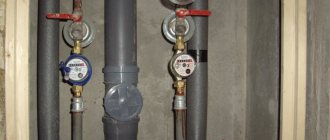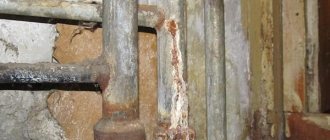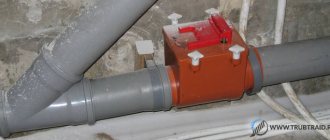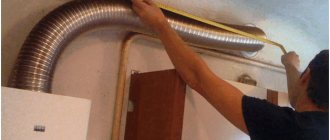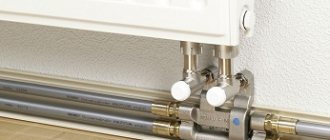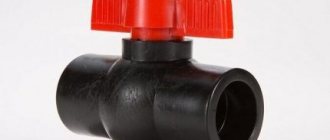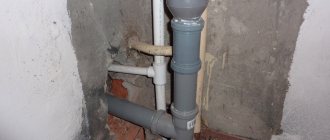In old houses, failure of the water supply system is a common occurrence. And installing an internal pipeline from modern materials or purchasing new plumbing fixtures does not solve the problem.
Only a complete replacement of the water supply risers in the apartment helps. Let us consider in more detail what requirements should be observed when performing a replacement and what stages the installation includes connecting the system.
When should you change?
Common reasons, other than major repairs, are:
- water leaks through fistulas as a result of severe corrosion of the pipe;
- the welding seam of the pipe has broken;
- there is no pressure, the pipes are clogged with deposits and rust;
- The apartment is being renovated and the pipes are being changed at the same time, so as not to return to this issue later.
Who should pay?
Who should maintain and repair the common property and networks of an apartment building depends on the chosen method of managing the building.
In case of direct management, which is allowed for houses with up to 30 apartments, repairs are carried out at the expense of the owner or an organization hired under a contract, within the framework of the terms of the contract.
Such an organization can be a management company (MC) or a network company that provides a utility service, in our case Vodokanal. A simple contract for house maintenance (not to be confused with a management contract), or only water supply networks, is concluded with them.
When managing the house of a management company or a homeowners association (hereinafter referred to as the management company), the responsibility to maintain and repair the water supply networks lies with them .
If the riser can be restored, for example, by welding the fistulas and seams, or cleaning the pipes with a cable, then the management company will do exactly that, and it will be right.
But in the case when the riser requires replacement and does not meet the requirements for safe operation, and the water pressure, even after cleaning the pipes, does not meet the requirements of the Rules for the provision of public utilities (Appendix 1, clause 3 of the RF Government Regulation No. 354 of 05/06/2011 .), the management company is obliged to carry out and pay for the work to replace the riser.
It is the owner's responsibility to provide access to the riser. Therefore, when repairing walls in bathrooms, it is worth thinking in advance about how to get to them.
If the required water supply parameters are provided, and the apartment owner still wants to change the riser, then in this case he will have to carry out the replacement himself, at his own expense.
At whose expense is it carried out?
Since regular payments are made for the apartment, such repairs are paid for by the residents.
That is, the housing office or management organization must pay directly for the repair itself. However, this only applies to situations where repairs are carried out to ensure the normal operation of communications and common property.
This usually refers to the following questions:
- Activities to achieve goals related to the maintenance of common property.
- Carrying out various types of maintenance of communications.
- If an accident of any kind occurs, eliminate it and put communications in order to continue normal operation.
- Carrying out various types of technical repairs that ensure the uninterrupted functioning of common property.
Who can carry out the work?
With the direct management method, the owners themselves determine who can be allowed to carry out work.
Most often, this decision is made by the apartment owner alone. In the future, all responsibility for the defect and damage caused will lie with him or with the organization that performed the work under the contract.
In a house with a management company, work to replace risers is carried out with the consent of the management company, since it is responsible for their safe operation.
Depending on the position of the head of the management company, the following may be allowed to work:
- qualified employees of the management company itself;
- specialized organizations or individual entrepreneurs;
- a private person with the appropriate qualifications.
The responsibility to check the specialization of the organization and the qualifications of its employees lies with the management company.
But the apartment owner should not neglect this either. Especially in terms of control during the execution of work.
The following documents or their copies certified by the head of the organization can serve as confirmation of specialization:
- extended extract from the Unified State Register of Legal Entities indicating the types of activities;
- documents on certification of responsible persons issued by Gostekhnadzor, the qualification commission of the organization itself;
- information on the official website of the organization;
- order for the enterprise on assigning qualifications to an employee.
Attention! Often, owners themselves carry out work to replace the riser, and even without the consent of the management company.
In this case, in addition to compensation for damage, there may be administrative liability for damage to water supply networks, and in case of significant damage, even criminal liability.
approximate price
The average cost of replacing 1 riser in central Russia ranges from 2,500 rubles for plastic pipes without passing through the ceiling , to 5,000 rubles with passing through the ceiling.
Replacing with any metal ones will cost 2,000 - 3,000 rubles more. In Moscow the price is 1.5 - 2 times higher. The approximate cost of work in a simplified form is shown in the table:
| Name of works | Cost, rub. |
| Dismantling the riser | 500 — 1000 |
| Riser installation | 1000 — 2500 |
| Passage of 1st floor | 500 — 800 |
| Passage of the 2nd floor | 500 — 800 |
| Cost of materials | 1000 — 1500 |
| Total: | 3500 — 6600 |
| Additional costs are possible for disconnecting, connecting, crimping the riser, sealing the water meter | At UK prices |
When discussing the final price, you should focus on market prices in the region, and not on the estimate provided by the contractor. The estimate can easily justify a cost that is many times higher than current prices.
Repair of pipes throughout the entire entrance
The most correct and least expensive way is to replace the riser in all apartments connected to it.
This will provide the following benefits:
avoid repeated work in the apartment, with damage to the finishing, when replacing risers from neighbors;- achieve a larger discount, since the contractor will be more interested in receiving a large volume of work;
- obtain a higher-quality pipe connection, without additional elements of transition from plastic pipes to steel ones;
- it is easier to resolve all organizational issues regarding disconnecting the riser;
- involve the management company as an organizer and supervisor of the work if the work will be carried out by a third-party organization;
- responsibility, in case of damage, will no longer lie with one owner, it can be assigned to the management company;
- you will not have to pay for disconnecting and connecting the riser.
Replacing the water supply riser in an apartment: with your own hands or with the help of a team
Hiring professionals to replace the water supply riser in an apartment means:
- saving effort, nerves and time;
- almost always a guarantee of excellent results;
- a considerable price for this type of service.
Attempting to replace the water supply riser yourself:
- significantly cheaper than contractor work;
- will require more time and labor;
- there is no guarantee of quality results.
In other words, when replacing the water supply risers in an apartment, the price can play a significant role in the choice of repair method.
To carry out such a replacement, you will need to take into account the cost of not only materials, but also tools. For example, cutting polypropylene pipes will require the use of a special device. But even if we take into account such expenses, replacing the riser yourself can be more profitable than involving a team of workers; the savings will be especially great if there is a significant amount of work to be done.
Repair through the management company
The most correct option in any case is to contact the Criminal Code in writing, which must conduct an examination and issue a verdict. If she agrees to a replacement, preferably in writing, all that remains is to wait for the actual completion of the work.
Reference! In case of refusal, it can be appealed to the State Housing Inspectorate.
To replace the riser through the management company, but at the expense of the owner, you also need to write to the management company and indicate in the application that you are ready to pay for this work.
In this case, the management company cannot refuse to perform the work, since it is obliged to provide paid services to the owners related to its type of activity. Replacing a riser is just such a service.
Application to the Criminal Code
To replace the riser, you must write an application. The application is written to the manager in free form.
It states:
- Last name, first name, patronymic of the applicant.
- Apartment address and phone number.
- The request itself to replace the riser.
- If it is assumed that the replacement should be made by the management company itself, then it is necessary to indicate the reasons for the malfunction of the water supply riser and the dangerous consequences that may occur due to the malfunction of the riser.
- If the replacement is planned on your own, then the date and time of replacement is indicated to turn off the riser, as well as the possible dismantling of the water meter, and therefore the seals.
Rules for connecting radiators to the riser
Methods for connecting a radiator to a riser
Replacing a riser is most often associated with a general modernization of the heating system. At the same time, not only new pipes are installed, but also radiators and batteries. It is important to choose the right scheme for connecting them to the heat supply system.
First, you need to equip the radiator so that it can effectively perform its functions. Its harness should include the following components:
- Shut-off valves . With its help, you can completely limit the flow of coolant into the battery for its repair or replacement;
- Thermostat . Necessary to reduce heat flow in order to reduce surface temperature;
- Mayevsky crane . Device for removing air pockets.
In addition to possible thermal insulation of heating risers, the layout of the supply lines is taken into account. For a one-pipe system, a bypass must be installed. This is a piece of pipe connecting the inlet and outlet pipes of the radiator. The diameter of the bypass should be one size smaller than that of the heating riser. In this case, the occurrence of a low pressure zone in the system can be avoided.
Experts recommend using identical pipes to connect the drain to the battery. This is necessary to normalize the operating parameters of the entire system, and will also significantly facilitate the complexity of installation. As an additional measure, pressure and temperature sensors can be installed. In this way, you can control the quality of the heating service.
To prevent premature battery clogging, it is recommended to install a strainer. It is mounted on the supply pipe in front of the thermostat.
Through a third party or individual
You can easily find dozens of offers for riser replacement services on the Internet.
It’s better to choose an organization; it will be easier to ask for quality.
To do this, it is worth concluding an agreement, otherwise you will have to prove the fact that the work was performed by this organization.
But a private owner can do it no less efficiently and cheaper. Here the choice depends on the caution of the owner and the amount of savings.
The management company also needs to write a statement about disconnecting the riser and agree on a replacement. Often the contractor himself does this for the owner. Payment for work should be made after the water supply has been restored and the tightness of the entire riser has been checked.
How does it change on its own?
This is the least desirable option. All responsibility in case of flooding of neighbors will be borne by the owner of the apartment. And perhaps the person who performed the work, if the owner proves that he did not know about the work, or was misled about the qualifications of the contractor.
Attention! If you do not agree on the replacement of the riser, much less notify the management company about this, then administrative liability for interfering with the operation of utility networks is possible.
But there is no direct legislative ban on carrying out work . You have to start the same way, with an application to the Criminal Code. In which it is requested to turn off the riser and it is mandatory, for safety reasons, to carry out pressure testing of the riser by the employees of the management company upon completion of the work.
In this case, there is a chance to share responsibility with the management company. In addition, it is worth pointing out the need to remove the seal from the meter and reseal it. It may be possible without unsealing, but it’s better to warn the Criminal Code.
If you can come to an agreement with the neighbors below and above, then it is better to connect to the old pipe from them.
Materials and tools
The easiest way is to replace any pipes with polypropylene ones, especially since you can even purchase pipes with a pressure of 25 bar for high-rise buildings. Most often this is what they do.
Tools for dismantling will be needed:
- angle grinder (grinder) with a cutting wheel for metal;
- small sledgehammer 3-5 kg;
- locksmith's key number 2-3;
- hammer drill or electric hammer.
For installation you need to prepare the following tools and materials:
- soldering kit for plastic pipes with scissors;
- tee for connecting an apartment;
- faucet for soldering to plastic, with the transition to residential wiring, taking into account the material of the internal water supply pipes;
- 2 transition elements for connecting a plastic pipe to a steel pipe (more about them below);
- 4 meters of pipe (2x2), taking into account the thickness of the ceiling and the approach to neighbors of 20 cm;
- wall mounting clamps;
- die for cutting threads on an old steel pipe
- 2 bends complete with couplings and locknuts if the threaded option is selected.
We recommend an article on the topic
Details about cold water pipes - what material to choose, how to determine the diameter and when is replacement needed?
Before purchasing materials, you need to think about how plastic pipes will be connected to steel ones, as well as how to connect the apartment. These are the most crucial and difficult moments in replacing the riser.
If the metal of the pipe is in good condition, then the best way is to cut a thread, then install the pipe on a coupling with a lock nut and connect it to the pipe with an adapter plastic coupling with an internal thread.
Such a connection can be serviced, and in the event of a leak, disassembled and repacked. Some contractors immediately screw the coupling onto the threads, guaranteeing that there will be no leaks. As a result, you still have to redo it, and relations with neighbors will be ruined.
Advice! You can cut threads on a pipe using grapple. You can do without a special key by turning it with a plumbing (gas) wrench. The Krupp has a guide skirt, so a reliable thread is obtained.
If the metal is severely corroded and there is doubt about the quality of the thread, then GEBO fittings are installed, specially designed for such a connection.
The pipes should be approximately equal in diameter . It is possible to use crimp clamps consisting of two halves with 4 bolts.
In this case, it is also important that both pipes are approximately the same diameter, and a rubber band is applied at the crimping point, which should compress the clamp. This method is the least reliable of all three.
When choosing a tee and a tap, you should think carefully, or better yet, pre-assemble a sequential chain: tee, tap, suitable threaded connection to the outlet to the apartment.
Metal pipeline
This is a traditional heating material. The operating temperature of the carrier in apartments can reach 110 C. In practice, this is quite rare, but 75–95 C is a common occurrence. Metal copes with this task perfectly.
Stainless steel – combining water and iron is not considered a good idea. Metal is susceptible to corrosion, and therefore unusual steel is used for communication systems - stainless or galvanized. The material has a lot of advantages and some disadvantages.
- Steel is very durable. 50 years is the typical lifespan of the system.
- Stainless steel is not subject to corrosion. In addition to the fact that this ensures durability, this property also determines the relative smoothness of the internal walls: the working diameter changes less over time, since salt and sediment are deposited to a lesser extent.
- Steel products can withstand not only high temperatures, but also pressure surges, which often occurs in a city apartment.
- Installation of heating risers made of steel pipes requires welding. The main difficulty is that bent structures are not possible here.
- The steel is quite heavy, so the system itself is more difficult to maintain and its assembly is not easy.
Copper piping is the most expensive option available. There are many advantages to this.
- This system is the most durable and reliable.
- Complete chemical inertness - copper does not interact with salts, alkalis, or acids.
- The working diameter of the heating riser pipe does not change over time, since the copper walls remain completely smooth.
Copper is a very ductile metal, installation is done by soldering, and bent structures do not cause any particular difficulties. And since metal is very decorative, there is no need to disguise pipes made from it.
It is not recommended to use galvanized steel for heating: salts and various active additives added to hot water quickly destroy the zinc coating. And without protection, steel quickly deteriorates.
Plastic pipeline: polypropylene and metal-plastic
Not all plastic can be used. Thus, ordinary polyethylene cannot withstand not only high pressure, but also the average operating temperature of the carrier.
Cross-linked polyethylene is a relatively new material, the main advantage of which is its resistance to high temperatures - it can withstand 95 C.
- The material is not subject to any type of corrosion. Moreover, it is resistant even to direct sunlight, which is usually no different from plastic.
- Chemical inertness is characteristic of all polymers.
- The ideal smoothness of the walls ensures that the diameter remains unchanged - no sedimentation until the end of its service life.
Light weight - installation is very simple.
A heating riser made of polypropylene pipes is the most affordable design. Moreover, it has all the other advantages.
- The polypropylene structure is connected by welding to fittings. The seams here are no less durable than the material itself.
- Temperature resistance and chemical inertness are no less than that of cross-linked polyethylene.
- Resistance to water hammer.
- The disadvantages inherent in polypropylene products include a high coefficient of thermal expansion. When installing the system, it is necessary to provide compensation loops and non-rigid fastening.
Metal-plastic pipes for heating risers do not have this drawback. This is a multilayer product, the role of the middle layer in which is played by a thin aluminum sheet - solid or profiled. It not only provides the pipeline with additional strength, but also compensates for thermal expansion.
- Simpler installation - connection to fittings of the appropriate diameter and the absence of compensation devices.
- Chemical inertness and resistance to high temperatures.
- Thanks to the metal layer, oxygen does not destroy the walls; the metal-plastic riser is much more durable.
- The construction cost will be higher.
Step-by-step instructions for changing
Replacement of the riser is carried out in the following order:
Open and do not close any water tap to drain. Make sure the riser is turned off and there is no water in it.- Disassemble the cold water supply unit into the apartment from the tap to the coarse filter following it, if possible without removing the meter. Secure the disconnected water supply so as not to damage its elements.
- Cut out the old riser inside your apartment, leaving 15-20 cm of pipe at the top and bottom to knock the pipe out of the ceiling.
- Cut out 15 cm of old pipe from the neighbors below near the ceiling, and from the neighbors above near the floor, so that you can remove the rest of the pipe from the ceiling.
- In your apartment, use a sledgehammer to knock out an old pipe from the ceiling. If it is not possible to knock it out, then use a hammer drill to hollow out the concrete around the pipe until it becomes mobile, and then knock it out again. There should be a second partner below who controls the exit of the pipe so that if it falls, it does not cause damage to the property of neighbors.
- Install fasteners for new plastic pipes in increments of no more than 40-50 cm, otherwise the pipes may bend and a leak will appear at the soldering site. This is typical for hot water, but it is also possible with cold water.
- Solder a tap into the tee to connect the apartment. You will need a piece of pipe for the transition of a smaller diameter. A tap with a tee is connected to the apartment water supply. This will allow you to accurately determine the location of the tee.
- Cut threads on the remaining old steel pipes using grapple. If this is not possible, move on to the second option, with GEBO fittings.
- Assemble the unit : screw the drive with a steel coupling and lock nut into a plastic coupling with an internal metal thread. Attach the squeegee to the old riser with a cut thread and connect them with a coupling. This is necessary to accurately measure the length of the plastic pipe and determine where to cut it.
- Insert new pipes into the holes in the ceiling and solder them into the tee. Fasten to the wall with clamps.
- Cut plastic pipes at the top and bottom at the level of the edge of the plastic coupling, taking into account the length of the inserted end of the pipe into the coupling when soldering.
- Remove the squeegee and the plastic coupling from the squeegee and solder the coupling to the plastic pipe. Then screw the squeegee into the plastic coupling. Screw a locknut and a steel coupling onto the drive. All threaded connections are sealed using sealant or fum tape.
- Attach the squeegee to the old threaded riser and connect them with a steel coupling. Lock the coupling with a locknut or install GEBO fittings. These operations are performed for both connections.
- Connect the internal water supply to the tap soldered into the tee. To eliminate the gap, you can use steel inserts from a bend or double-sided thread.
- Invite management company employees to accept work and supply water to the riser.
- Turn on the riser to pressurize the mounted section of the riser with operating pressure. Why does one person open the tap at the bottom of the riser, and the second must monitor the presence of leaks. If a leak appears, give a signal to close the riser, then repack the current connections.
Attention! If there are no leaks, the work is considered completed.
Tips for those who want to replace the sewer riser along with the water supply riser
Changing the sewer system pipes in an apartment requires calculations that are somewhat more complicated. Note that dismantling in this case is not easy. However, the assembly of new structures is still faster than pipes with cold/hot water. After all, the drain pipes are connected through a socket using a sealing ring, so there are no particular difficulties in this operation - except that the work itself will be somewhat dirtier than when replacing water pipes or heating systems.
Replacing sewer pipes in an apartment consists of three steps:
- Initially, you will need to update the siphon elements that are located under the sinks. Next, calculations are performed to determine the slope of the pipes that connect the riser and siphon. Slope refers to the difference in height above the floor between the entrance of the pipe and its exit. The entrance is located under the siphon itself, the outlet part is on the tee of the fan riser. This height difference is directly determined by the length of the pipe.
As a rule, a pipe with a diameter of 5 cm is laid with a slope of 2.5–3.5 cm per linear meter. After determining this value, it will be necessary to project the dimensions onto the surface, which will serve as a support for the planned sewer pipe. To do this, draw the position of the branch directly on the wall. Next, you can begin dismantling the old drain pipes.
- You will need to remove the fan riser, having first blocked it. When removing, a pneumatic plug is inserted into the collapsible end of the riser revision; it will act as a plug from the neighboring drains. After this, you need to extremely carefully caulk the central tee - it is responsible for connecting all the drain pipes in the apartment. After this, they get rid of the old pipes; this operation does not require any special actions. If these are cast iron products, they are simply hit with a hammer and the broken parts are thrown away.
- Then you need to assemble it. First, a polyvinyl chloride pipe is installed. It is responsible for connecting the toilet flush and a tee with a diameter of 10 cm (cast iron). Next, drain pipes leading from the sinks and bathtub are connected to the tee. Their diameter is 5 cm. The operation is simple - the smooth end of the pipe is connected to the socket.
After this, the revision is freed from the plug, and the riser itself is hermetically sealed by simply screwing on the caps. At this point, the replacement of sewer pipes is considered complete, and the new drainage system is ready for use.
Cooperating with is reliable and prestigious. The specialists working here are professionals of the highest level. operates throughout Moscow and the Moscow region.
